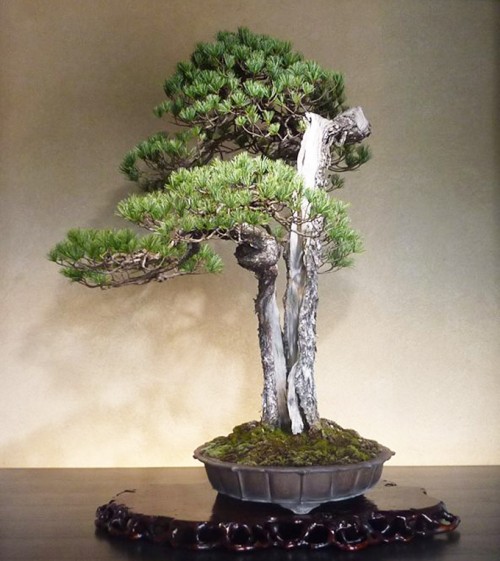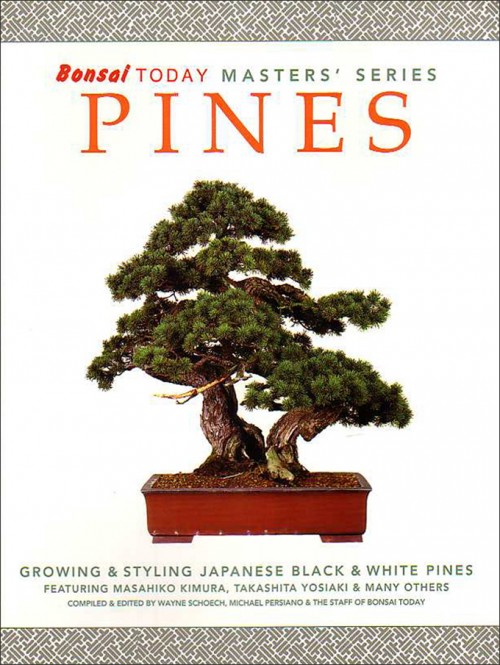 Mulitple trunk, raft-style Japanese white pine. This is a truly spectacular example of raft style bonsai. It’s mature and abundant, with a flowing natural feel that is the result of bonsai artistry at its best (nature too). In fact, it’s so spectacular that it has a name (Maiko – Dancer). In Japan, names are usually reserved for the best bonsai. This tree resides at the Omiya Bonsai Art Museum, as do all five trees in this post (from Omiya’s timeline on facebook).
Mulitple trunk, raft-style Japanese white pine. This is a truly spectacular example of raft style bonsai. It’s mature and abundant, with a flowing natural feel that is the result of bonsai artistry at its best (nature too). In fact, it’s so spectacular that it has a name (Maiko – Dancer). In Japan, names are usually reserved for the best bonsai. This tree resides at the Omiya Bonsai Art Museum, as do all five trees in this post (from Omiya’s timeline on facebook).
All the trees in this post are Japanese white pines that reside at the Omiya Bonsai Art Museum in Saitama Japan. Japanese white pines (Pinus parviflora) are native to Japan. All white pines have five needles to a bundle, so the Japanese white is often called Japanese five needle pine (Pinus pentaphylla).
For a number of reasons, Japanese white pines are prized in bonsai circles. Not the least of these is small needles (unlike our native Pinus strobus) and handsome greyish bark. Then there’s the fact that they take so well to bonsai culture.
A common bonsai practice is grafting White pines onto root-stock from the more vigorous Japanese black pine (Pinus thumbergii), which makes for faster growing and stronger trees than White pines on their own stock. Almost all of the imported White pine bonsai are grafted on Black pine stock.
Another positive feature of the Japanese white pine is its winter hardiness. Here in northern Vermont where temperatures are known to get as low as -20F to -30F (even colder in the old days), they can survive in the ground if you provide protection from the wind and a heavy mulching. In bonsai pots, you would want somewhat higher temperatures and very good protection.
For the past fifty or sixty years Japanese white pine bonsai have been exported from Japan to destinations all over the West. However, the very best usually stay home. For this reason, you will seldom see Japanese whites here in the West that are as developed as ones shown here.
 Do you recognize this tree? It first appeared in Bonsai Today magazine and later had a whole chapter devoted to it in our Pine book (Jewel to Whirlpool). The artist was Tomio Yamada (at least at that time). It’s called Uzushio which as you might guess, means whirlpool. Like the other trees in this post, it resides at the Omiya Bonsai Art Museum.
Do you recognize this tree? It first appeared in Bonsai Today magazine and later had a whole chapter devoted to it in our Pine book (Jewel to Whirlpool). The artist was Tomio Yamada (at least at that time). It’s called Uzushio which as you might guess, means whirlpool. Like the other trees in this post, it resides at the Omiya Bonsai Art Museum.
 Like the one just above, this one shows a strong trunk that tell a story of hardship and survival. Like most of the others at the Omiya Museum, it has a name: Shungaku (Shungaku was a historical figure, though my extensive 30 second research didn’t reveal much detail).
Like the one just above, this one shows a strong trunk that tell a story of hardship and survival. Like most of the others at the Omiya Museum, it has a name: Shungaku (Shungaku was a historical figure, though my extensive 30 second research didn’t reveal much detail).
 Multiple trunk Japanese white pines are quite common. Though not as dramatic or old as the one at the top of the page, still it shows great movement and balance, with a nice light, almost floating effect. Rather than a name, the artist, Kenichi Abe, is listed with this tree.
Multiple trunk Japanese white pines are quite common. Though not as dramatic or old as the one at the top of the page, still it shows great movement and balance, with a nice light, almost floating effect. Rather than a name, the artist, Kenichi Abe, is listed with this tree.
 This one is called Sokaku (nest of the cranes). It’s unusual, with it long straight split trunk. I like the loop on the left half of the trunk. Though you don’t see it very often, you can create split trunk bonsai with a trunk splitter some other tools and a little patience and skill.
This one is called Sokaku (nest of the cranes). It’s unusual, with it long straight split trunk. I like the loop on the left half of the trunk. Though you don’t see it very often, you can create split trunk bonsai with a trunk splitter some other tools and a little patience and skill.
All the bonsai in this post are from the Omiya Bonsai Art Museum’s timeline on facebook.
 Would you like to learn more about Japanese white pines? If you do, this book is what you need.
Would you like to learn more about Japanese white pines? If you do, this book is what you need.